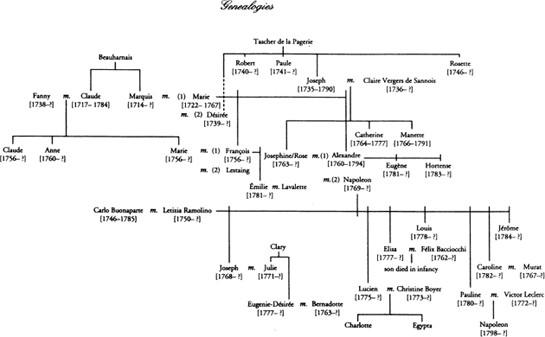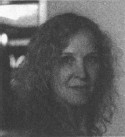Tales of Passion, Tales of Woe (47 page)

Adélaïde Hoche:
Lazare Hoche’s young wife
Agathe:
Josephine’s scullery maid
Alexandre Beauharnais:
Josephine’s first husband; guillotined during the Terror
Antoine:
the coachman
Barras, Paul:
a director; Josephine’s friend and mentor
Botot, François:
Barras’s secretary
Bruno:
Barras’s hall porter
Callyot:
Josephine’s cook
Caroline (Maria-Anunziata) Bonaparte:
Napoleon’s youngest sister
Charles, Captain Hippolyte (“Wide-Awake”):
Josephine’s intimate friend and business partner
Crény, Madame de:
one of the Glories
Désirée Renaudin:
Josephine’s godmother and aunt; she lives with the Marquis
Elisa (Maria-Anna) Bonaparte:
the oldest of Napoleon’s sisters; married to Félix Bacchiochi
Émilie
Beauharnais:
Josephine’s niece
Eugène Beauharnais:
Josephine’s son
Fauvelet Bourrienne:
Napoleon’s secretary
Fesch:
Bonaparte’s uncle (by marriage)
Fortuné:
Josephine’s first pug dog
Fortunée Hamelin:
one of the Glories
Fouché, Joseph:
Josephine’s friend, talented in undercover work
Gontier:
Josephine’s manservant
Hortense Beauharnais:
Josephine’s daughter
Hugo and Louis Bodin:
Josephine’s business partners
Igor:
Barras’s parrot
Jérôme (Girolamo, Fifi) Bonaparte:
Napoleon’s brother, his youngest sibling
Joseph (Giuseppe) Bonaparte:
Napoleon’s older brother, married to Julie Clary
Julie Clary:
Joseph’s quiet wife
Junot Andoche:
one of Napoleon’s aides
Lazare (Lazarro) Hoche:
Josephine’s former lover
Lavalette:
one of Bonaparte’s aides-de-camp
Letizia Bonaparte:
Napoleon’s mother
Lisette (Louise) Compoint:
Josephine’s lady’s maid
Louis (Luigi) Bonaparte:
Napoleon’s younger brother whom he raised like a son
Lucien (Lucciano) Bonaparte:
Napoleon’s fiery younger brother
Marquis de Beauharnais:
the father of Alexandre, Josephine’s first husband, and François, Émilie’s father
Mimi:
Josephine’s childhood maid, a mulatto from Martinique
Minerva (Madame de Châteaurenaud):
one of the Glories
Moustache:
Napoleon’s courier
Napoleon (Napoleone, in Italian) Bonaparte:
Josephine’s husband.
Ouvrard:
a financial genius
Pauline (Maria-Paola, Paganetta) Bonaparte:
Napoleon’s beautiful and spirited younger sister
Pegasus:
Eugène’s horse
Père Hoche:
Lazare Hoche’s father
Pugdog:
Josephine’s second pug dog
Talleyrand, Charles-Maurice:
a former bishop, sometimes Minister of Foreign Affairs, always influential
Tallien, Lambert:
Thérèse’s husband
Thérèse (Tallita, “Amazon”) Tallien:
Josephine’s closest friend, one of the Glories
Toto:
Barras’s minature greyhound

P.S.
Ideas, interviews & features
Author Biography
In the Author’s Own Words
Mud Baths & Dusty Coffins: In Search of Josephine B.
An Interview with Sandra Gulland
Recommended by Sandra Gulland
Web Detective
An Excerpt from
The Last Great Dance on Earth

Sandra Gulland
SANDRA GULLAND
was born in Florida in
1944.
Her father was an airline pilot, so the family moved often, living in Rio de Janeiro, Brazil, then Florida again before settling in Berkeley, California.
In the fall of
1970,
Gulland moved to Canada to teach Grade
2
in an Inuit village in northern Labrador, an experience she describes as “amazing.” Later, she worked as a book editor in Toronto, and in
1977
she married Richard Gulland. She gave birth to a daughter and son, and in
1980
the family moved to a log cabin near Killaloe (population
600),
in northern Ontario. Gulland started an editorial and writing service, and became the principal of a parent-run alternative school. All the while, she grew vegetables (or “tried to grow vegetables,” as she puts it), raised chickens and pigs, and developed a lifelong fascination with horses. Meanwhile, and always, she was writing.
Gulland’s consuming interest in Josephine Bonaparte was sparked in
1972
when she read a biography about her. Decades of in-depth research followed, which included investigative trips to France, Italy and Martinique, consultations with period scholars and learning French.
The Many Lives & Secret Sorrows of Josephine B.
was published in
1995.
It was followed in
1998
by
Tales of Passion, Tales of Woe
and
The Last Great Dance on Earth
in
2000.
The Josephine B. Trilogy is now published in thirteen languages. Napoleon said that he “conquered countries but that Josephine conquered hearts,” Gulland says. “It’s astonishing. She continues to do so.”
Gulland added to this hugely successful trilogy in 2008 with
Mistress of the Sun,
a novel based on the life of Louise de la Vallière, extraordinary horsewoman and consort to King Louis XIV.
Gulland and her husband now live half the year in San Miguel de Allende, Mexico, and half in northern Ontario.
“What was Napoleon and Josephine’s bedroom is now a school lunchroom, a plaque on the wall the only evidence that they were ever there.”
Mud Baths & Dusty Coffins: In Search of Josephine B.
From an article by Sandra Gulland, originally published in
The Globe and Mail,
July 25, 1998.
Over two decades ago, I was rather badly bitten by a curiosity bug:
Josephine B.,
it whispered. As in Bonaparte. As in wife of Napoleon. As in, simply, Josephine.
The symptoms of this affliction are obvious: books overflowing shelves, curios gathering dust, obscure portraits covering the walls of my house.
It was a case both chronic and acute: I gave up my day job as an editor and crossed the line, as they say, to the other side. I became an author. Seeking Josephine has been an adventure on a global scale. Researching the first book took me on missions to Paris and to Martinique, where Josephine was born and raised. For the second, I traced her voyage through northern Italy and into the Vosges Mountains of France.
Among the places I travelled was Mombello, Josephine and Napoleon’s summer residence during the first Italian campaign. Described in other books as palatial, the villa surprised me with its small proportions. What was their bedroom is now a school lunchroom, a plaque on the wall the only evidence that they were ever there. In Milan, their Palazzo Serbelloni was also a far cry from the glittering confection commonly described. Now it is a government office building. In Josephine’s suite, the
rooms were small and dark. No wonder she was unhappy here, I thought. The sumptuous villa Manin di Passariano, northeast of Venice, on the other hand, stunned me with its majesty. It was there that Josephine smoothed tempers as Napoleon negotiated a peace treaty with Austria. But nowhere revealed more to me about Josephine than the tiny spa of Plombières-les-Bains in the mountains southeast of Paris.
I arrived there at night. Immediately after arriving in my room, I opened the doors to the balcony facing out over the village. The ancient grey houses clustered along a mountain valley, “as if they had tumbled into a crevice and were too weary to rise,” as I had Josephine describe it in the novel. She loved Plombières, as had her daughter Hortense and Hortense’s son “Oui-Oui” (also known as Napoleon III).
Doctors had recommended that Josephine “take the waters” at Plombières because she’d been unable to conceive a child with Napoleon. (Today, the waters are believed to cure intestinal problems and rheumatism, although not infertility.) As modest as the village is, it had been visited by almost all the royals and demi-royals of Europe of the late 18th and early 19th centuries. Its appeal, and its history, can be traced to the Romans, who had also come for the hot mineral water that surges through the rocks under the village.
The day after my arrival, I presented myself at the deluxe Thermes Napoléon, where I managed to convey that I wished to try a variety of water treatments such as those Josephine herself might have taken in the late 18th century. An amused nurse ticked off a number of items on a card. Then, in blue plastic
pantouffles
and a white terry robe, I shuffled through the vast, wet marble halls to my first treatments:
bain radio-gazeux
(a Jacuzzi gone mad), and
compresse thermale
(a series of steaming towels). For my third treatment, I was encased in a heavy cocoon of warm mud followed by a vigorous massage under a shower.
“Nowhere revealed more to me about Josephine than the tiny spa of Plombières-les-Bains in the mountains southeast of Paris.”
“I’d gone to mass in the church of Josephine’s childhood; this was the church of her death.”
After a few inquiries, I located where Josephine had stayed nearby. The former inn was smaller than I’d expected. I looked up at the windows to her corner room (now a dentist’s office), examined the height of the balcony that had given way under her, the fall nearly leaving her crippled. Immediately after her fall, a sheep was slaughtered and she was wrapped in its skin. Musicians had serenaded her as she healed, likely standing on the very cobblestones I myself was occupying.
